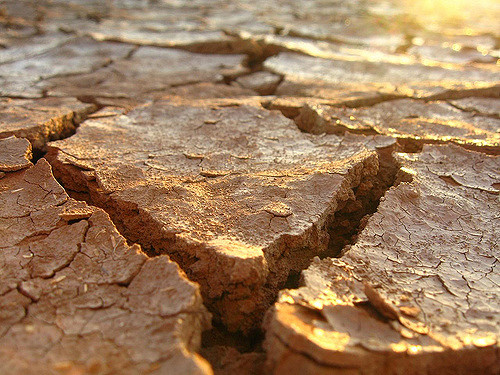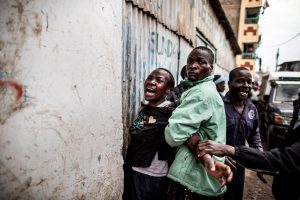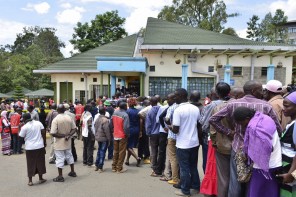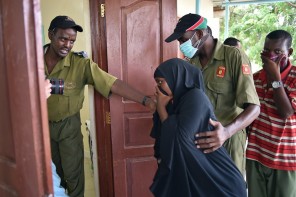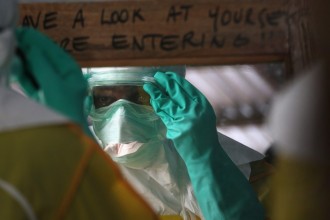by Jina Moore, for Pacific Standard, Winter 2012 (no longer available online)
Brenda Wandera’s iPhone buzzes in her lap. A text message has made its way through the blurry heat of Kenya’s Chalbi Desert, and it changes her next move. “As soon as we get to Kalacha, we have to go to Network,” she says.
Go to Network, I wonder. That must be a Kenyan turn of phrase for “finding a cell tower.”
I’ve been warned that Kalacha is off the grid, which would make it one of the more remote corners of Africa, where mobile-phone and Internet service in even far-flung villages can be stronger and more regular than in parts of the American Southwest or Appalachia. Indeed, Kalacha is isolated. It sits in northern Kenya, about 40 miles from the border with Ethiopia, just at the edge of the Chalbi. Rounded huts of thatched grass zigzag across dry land. The horizon is dark and bulbous and looks very, very far away.
Our Land Cruiser drives toward one of those bulbs, a massive mound of volcanic rocks. Wandera hops out of the car, clutching her iPhone, and springs up the uneven hillock, 30 or so feet tall. At the top, a half dozen local women huddle on one edge. Their abayas — lemon-yellow, tomato-red, sequined garments — look especially colorful against the monochrome flatlands stretched out below. They chat on cell phones tucked under their tightly pulled scarves.
Wandera claims the other side of the mound. In black kitten heels, she hops from one irregular rock to the next until she finds a stable perch. Then she lifts her phone above her head and waves it at the sky. It turns out this mound is Network — the only place between here and forever where you can make a phone call, if you catch the wind just right.
Wandera reaches her boss, whose caravan from Ethiopia has been delayed. Andrew Mude is bringing 12 elders from across the border to witness the small institutional miracle he and Wandera have pulled off. Thanks to them, in Kalacha, cows have insurance.
Wandera manages an innovative insurance program that offers cash-poor pastoralists low-priced insurance for their only assets: livestock. The plan was crafted precisely for places as remote and vulnerable as Kalacha. Here, each morning, men set out with their cattle to look for pasture. Women and girls wait at wells for their turn to pump water into yellow plastic jugs, then haul it on their heads back home, where thirsty goats wait impatiently. The camel herders have it the hardest; the roving Gabra tribesmen move endlessly across the desert.
For these pastoralists in northern Kenya, where most people don’t have bank accounts, cows and camels are cash. If animals die in large numbers, families go bankrupt.
That makes drought one of the biggest financial risks that people face here. “In this area, you get a severe drought about once every four years,” says Mude, an economist with the International Livestock Research Institute in Nairobi. Severe drought can kill off as much as a third of a herd, he says. That level of devastation is like losing your home to a fire or totaling your only car.
Americans hedge against such risks with insurance, paying monthly premiums in order to be compensated if disaster strikes. Americans insure almost everything — cars, houses, boats, artwork, cell phones, even their bodies — against almost every kind of risk: fires, floods, theft, sickness, death. This works because a system exists for vetting claimants: insurance adjusters verify and appraise all damage, whether from a fire or a fender bender. Insurance companies can afford that personnel-intensive model of verification because most of us are buying insurance, paying into the companies’ large pools of funds, and we’re generally easy to find.
But in northern Kenya, traditional insurance is impossible. The vast area is mostly without roads, and villages are difficult to reach. “It would be really quite expensive” to make a conventional system profitable in such a remote area, Mude says.
The same problem besets many other rural communities in developing countries. So six years ago, the United Nations’ World Food Programme piloted a new insurance model in Africa.
Visiting farms to appraise damage would be too expensive, so WFP found another way of “verifying” that crops were succumbing to drought. In Ethiopia, researchers took rainfall data and crossed it with harvest data. Statistical analysis proved mathematically what the farmers already knew from experience: low rainfall levels suggest that crops are going to die, and when crops dies so do animals.
WFP’s rainfall-index insurance was the first of its kind in Africa. The industry was pioneered in India, and it has since expanded. Today, rural farmers can buy rainfall insurance for crops in Malawi, Rwanda, and the Philippines, among other places. Premium prices are low, ranging from about $3 to $10 — even in distant, poor communities.
A good index depends on data that are easily available and objectively verifiable. Farmers and insurance providers alike trust government data on rainfall, and each group can find that information independently. But the data also have to relate directly to the problem. Whether crops die depends more on how much rain falls in a season than, say, the number of cloudy days.
When Mude and his research team, in concert with researchers at Cornell University, decided to build an index for livestock insurance, they needed two sets of substantial data. The first set was easy to come by: statistics on livestock mortality have been available from the Kenyan government since 2000. Finding the second set was more complicated. Rainfall data isn’t easily available here, and micro-regions can experience quite different weather patterns, making rainfall too inexact a measurement. For the index to work, the team had to find something that measured how much food was available for herds.
Since the 1980s, NASA has used satellite pictures to measure global drought. Every 10 days or so, a satellite snaps a picture of the northern Kenyan plains and adds the information to a free public database that shows how green or brown the ground there is. The logic seems obvious: without green stuff to eat, cows and goats will probably die. But the economists had to confirm that the two different sets of data had a strong statistical relationship and then use that to predict what portion of a herd might die under various weather conditions.
The resulting formula became the basis for Index-Based Livestock Insurance. The index enabled a private insurance company to create policies for northern Kenya’s herders. “The index is a way to ascertain the kind of information we need,” says Anthony Muthiora, a policy manager at UAP, the Nairobi-based private insurance partner for IBLI. “We can’t go up there and confirm, ‘That grass there should [feed] about 15 animals.’”
Making the math work was only half the battle. Explaining the product to pastoralists was another matter. Mude and his team use games and theatrical skits to convey the concept of insurance. But to explain how insurers will know what’s happening to the animals — how the satellite figures in the process — they use a different metaphor.
“These are populations who understand the stars very well,” Mude says. “They are aware that there are ‘stars’ that move around at night that are different from permanent stars. We let them know these moving stars are satellites taking pictures.”
• • • • • • • • • • • • • • •
In the winter of 2010, during one of Kenya’s worst droughts in recent memory, Marsabit District is as brown as Ireland is green. The district, IBLI’s pilot region, which includes Kalacha, is seven hours, by rickety overnight bus, from the end of Kenya’s paved northern road, and the population, estimated at 144,000 in 2008, is spread thinly across the 66,000 square miles. No one really knew if the insurance program would work here. But the costs were low enough, and the institutional infrastructure stable enough, that the policies sold well, even in the first year.
Insuring a goat in the driest and most expensive part of Marsabit costs a little more than a dollar. A cow costs about $10, and a camel costs $14. To pay for the policies, bought mostly for their most valuable animals, most herders sell a few goats.
But how do you collect and keep track of $1 payments across a barely inhabited region? Though the team at the International Livestock Research Institute built the index that makes the insurance work, a private insurer sells the policies and covers its risk by taking out a policy with a reinsurance company. Herders hand cash to a sales agent, who works for a bank and travels between villages. He carries a kind of portable cash register, a handheld device that uses cell phone networks to register payments and print receipts.
Insurance money doesn’t flow out as soon as things start looking dry. The data are analyzed over time, and any payouts are made at the end of the dry season. To trigger a payout, things have to be really dry: the policies are built to protect herders against catastrophic livestock mortality — deaths in numbers so great that a family might never financially recover. IBLI sets that threshold at 15 percent of the herd. If the satellite shows drought so severe that the index predicts that more than 15 percent of the livestock will die, herders get paid for every animal they’ve personally insured. At the end of the second dry season covered, the payments totaled around 1,850,000 Kenyan shillings — or about $20,650 U.S.
At this stage, the insurance products aren’t making enough money to interest private insurers in developing them on their own. In 2009, the pilot year, the IBLI team sold nearly 2,000 insurance policies, totaling almost $47,000 in premiums. And in a purely commercial market, an insurance product with such low premiums couldn’t exist. That’s why nongovernmental organizations are at the forefront of weather-index insurance pilots in Kenya and elsewhere. Insurance companies are willing to join these experiments now, though, because of the possibility that the market for small-scale insurance could explode, as micro-banking did in the last decade. Still, at some point, someone has to make some money.
To succeed in the long term, “commercial viability is an absolute requirement,” says Martin Buehler, the principal insurance officer at the International Finance Corporation, which manages a program and associated trust fund that support six early weather-index-insurance projects around the world, including IBLI. Buehler believes such programs will need three to five years in areas as challenging as northern Kenya to become profitable.
“It falls along the spectrum between pure capitalism and pure altruism,” says Jürg Trüb, the managing director for environmental and commodities markets at the global reinsurance giant Swiss Re. But as the market develops, policies can take off. In India, which Trüb says is the only commercial market in weather-index insurance so far, he saw annual premium sales jump from $100,000 to $100 million in seven years. With that kind of tantalizing growth in mind, the IBLI team is planning to expand into southern Ethiopia.
• • • • • • • • • • • • • • •
Meanwhile, in Kalacha, one enterprising young man realized that, even with small-scale insurance, speculation could pay off. Abdinoor Kochale understood sooner than most what the index really means: It doesn’t matter if your cows or camels actually die; it only matters if the index says they probably will.
Kochale gambled that he might be able to turn probability into profit. If a drought were bad enough to trigger the index, he’d get paid for his insured animals. But if he were clever or lucky enough to keep his animals alive, he’d end up with cash and animals.
So he chose to insure several camels. Camel premiums cost the most, but they pay out the most. And Kochale knew that camels are the most drought-resistant livestock in the region. “If the index triggers, I’m in a good situation because I’m going to be compensated, and the camels are still going to be there,” he explains, grinning with self-assurance.
Still, as the drought stretched on in 2010, herders in three of the pilot villages grew frustrated. Some said they had seen their cattle die but had heard nothing from their insurer. Others complained of losing cattle to raids or disease — circumstances that aren’t insured — and asked for a program that covered more risks. Most simply felt confused. They knew the satellite was collecting information, but no one had told them what it was saying. The drought seemed so obvious to them; why couldn’t the satellite see it?
“Me and you could go around and see that livestock can’t graze in the forest,” one frustrated pastoralist shouted during a mid-February community meeting in the village of Dirib Gombo. The forest might look green from space, he argued, but on the ground, the land where cattle graze was dry and useless.
Mude acknowledges that his team could ease some frustrations by providing regular updates about the satellite data. But they’d still have another problem. George Gerada Nerada, the chief of Dirib Gombo, says that his villagers are confounded by how the formula relates to their daily lives. “What our people know is what they see and what is happening around them. Everybody knows that the drought is there, that there’s no grass for their animals, and they’re expecting the insurance people will pay them something at least.”
The IBLI team has tried to focus herders on the narrow slice of probability that the insurance actually covers: catastrophic drought. The formula factors in a certain level of normal livestock mortality — the usual number of cows a herder can expect to lose during typically dry periods. On a visit to the pilot villages, Brenda Wandera explains premium payments like this: “If you get a night watchman to keep people from stealing at your house, but at the end of the month no thieves came, you’re not going to not pay the watchman.” Usually, her explanation is accepted half-heartedly.
The dissatisfied villagers of Dirib Gombo get no sympathy from some IBLI customers, like the respected local elder Adan Sora, who persuaded a group of men to take out policies. Sora sold some goats to insure five of his cattle in 2010, and he says he’ll insure again next year. But he adds that he’s known for months that the drought won’t get bad enough to trigger a payout, because he and his fellow elders have been consulting an index of their own.
“We read the intestines of animals. Whenever an animal is slaughtered, it can help predict the coming rain,” Sora says. “The intestines also indicate whether a reduced rainfall is going to cause the massive death of livestock. The current reading tells us that the rains will be late, but the animals will not die.”
He pauses for a moment, reflecting. “Actually, that’s what we’re seeing,” he says. “Normal death at this point.”

